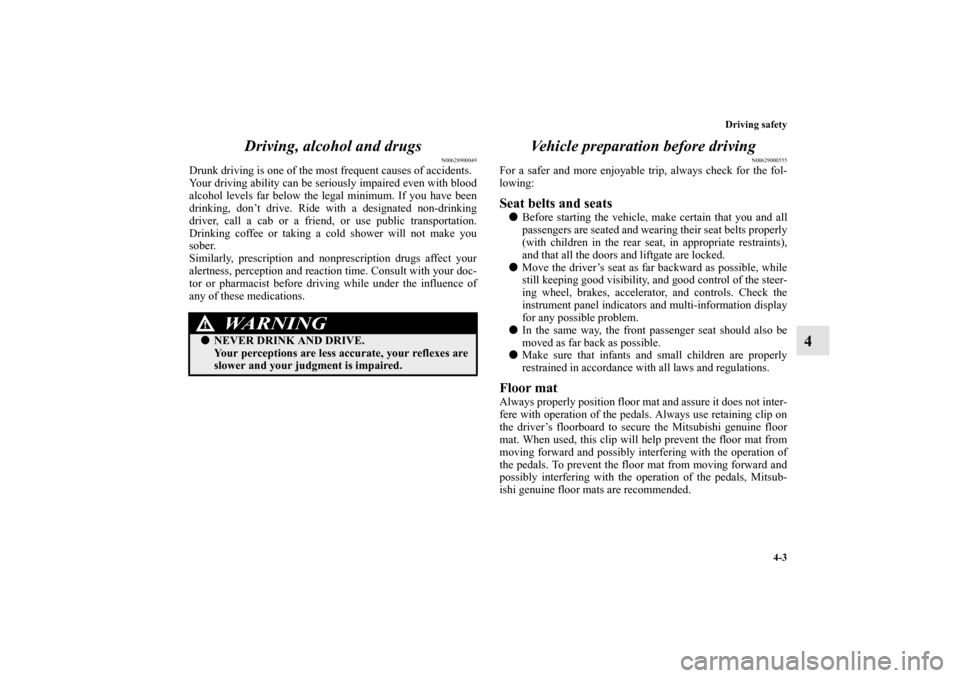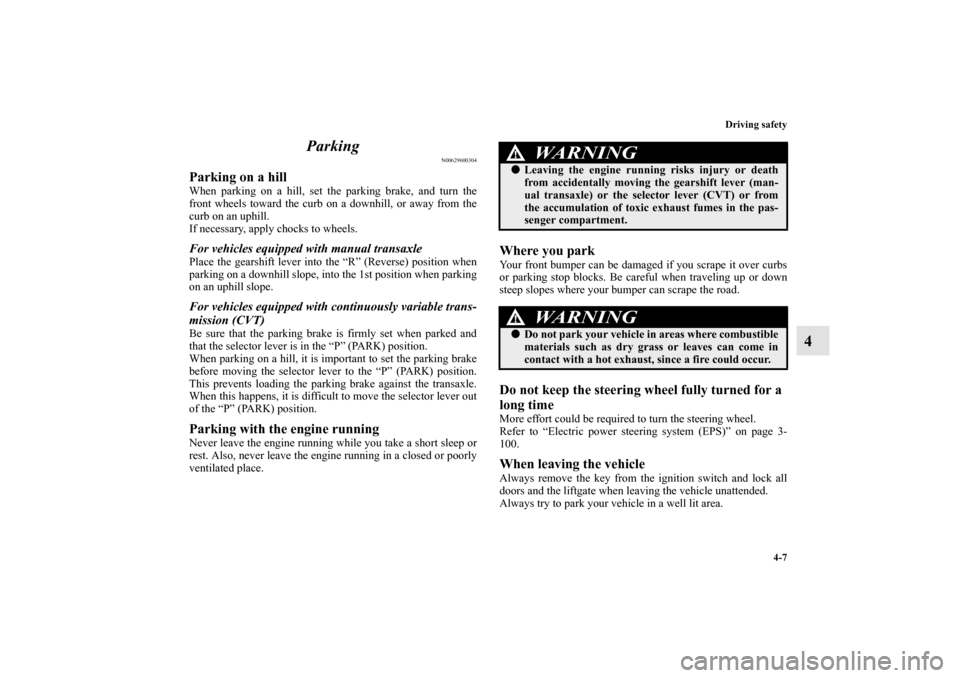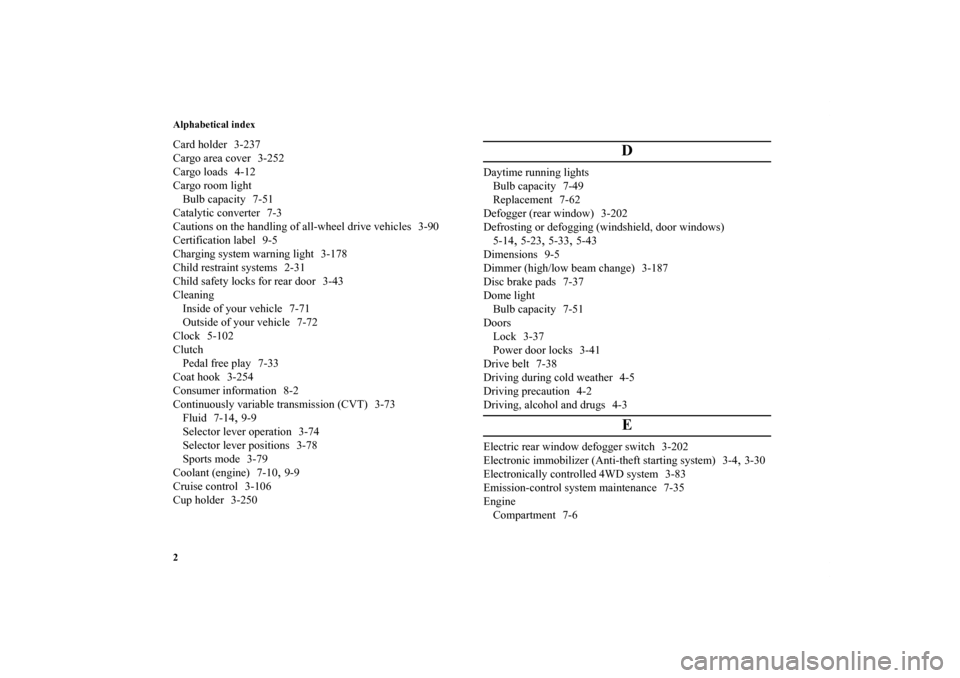Page 350 of 602
Features and controls
3-253
3
2. Hang the strap (C) of the cargo area cover on the hook
(D).To removeFollow this procedure in reverse to remove.
Assist grips
N00559000045
The assist grips (located above the doors on the headliner) are
not designed to support body weight. They are intended for use
only while seated in the vehicle.
CAUTION
!�Lightly push the cargo area cover to make sure that
the concave portion (A) is set firmly in the protrud-
ing portion (B) of the liftgate. If the cargo area cover
is not securely locked in place, it could unhook while
driving and cause injuries.
CAUTION
!�Do not use the assist grips when getting into or out
of the vehicle. The assist grips could detach causing
you to fall.
BK0120400US.book 253 ページ 2010年5月12日 水曜日 午前10時50分
Page 356 of 602

Driving safety
4-3
4 Driving, alcohol and drugs
N00628900049
Drunk driving is one of the most frequent causes of accidents.
Your driving ability can be seriously impaired even with blood
alcohol levels far below the legal minimum. If you have been
drinking, don’t drive. Ride with a designated non-drinking
driver, call a cab or a friend, or use public transportation.
Drinking coffee or taking a cold shower will not make you
sober.
Similarly, prescription and nonprescription drugs affect your
alertness, perception and reaction time. Consult with your doc-
tor or pharmacist before driving while under the influence of
any of these medications.
Vehicle preparation before driving
N00629000555
For a safer and more enjoyable trip, always check for the fol-
lowing:Seat belts and seats�Before starting the vehicle, make certain that you and all
passengers are seated and wearing their seat belts properly
(with children in the rear seat, in appropriate restraints),
and that all the doors and liftgate are locked.
�Move the driver’s seat as far backward as possible, while
still keeping good visibility, and good control of the steer-
ing wheel, brakes, accelerator, and controls. Check the
instrument panel indicators and multi-information display
for any possible problem.
�In the same way, the front passenger seat should also be
moved as far back as possible.
�Make sure that infants and small children are properly
restrained in accordance with all laws and regulations.Floor matAlways properly position floor mat and assure it does not inter-
fere with operation of the pedals. Always use retaining clip on
the driver’s floorboard to secure the Mitsubishi genuine floor
mat. When used, this clip will help prevent the floor mat from
moving forward and possibly interfering with the operation of
the pedals. To prevent the floor mat from moving forward and
possibly interfering with the operation of the pedals, Mitsub-
ishi genuine floor mats are recommended.
WA R N I N G
!�NEVER DRINK AND DRIVE.
Your perceptions are less accurate, your reflexes are
slower and your judgment is impaired.
BK0120400US.book 3 ページ 2010年5月12日 水曜日 午前10時50分
Page 360 of 602

Driving safety
4-7
4 Parking
N00629600304
Parking on a hillWhen parking on a hill, set the parking brake, and turn the
front wheels toward the curb on a downhill, or away from the
curb on an uphill.
If necessary, apply chocks to wheels.For vehicles equipped with manual transaxlePlace the gearshift lever into the “R” (Reverse) position when
parking on a downhill slope, into the 1st position when parking
on an uphill slope.For vehicles equipped with continuously variable trans-
mission (CVT)Be sure that the parking brake is firmly set when parked and
that the selector lever is in the “P” (PARK) position.
When parking on a hill, it is important to set the parking brake
before moving the selector lever to the “P” (PARK) position.
This prevents loading the parking brake against the transaxle.
When this happens, it is difficult to move the selector lever out
of the “P” (PARK) position.Parking with the engine runningNever leave the engine running while you take a short sleep or
rest. Also, never leave the engine running in a closed or poorly
ventilated place.
Where you parkYour front bumper can be damaged if you scrape it over curbs
or parking stop blocks. Be careful when traveling up or down
steep slopes where your bumper can scrape the road.Do not keep the steering wheel fully turned for a
long timeMore effort could be required to turn the steering wheel.
Refer to “Electric power steering system (EPS)” on page 3-
100.When leaving the vehicleAlways remove the key from the ignition switch and lock all
doors and the liftgate when leaving the vehicle unattended.
Always try to park your vehicle in a well lit area.
WA R N I N G
!�Leaving the engine running risks injury or death
from accidentally moving the gearshift lever (man-
ual transaxle) or the selector lever (CVT) or from
the accumulation of toxic exhaust fumes in the pas-
senger compartment.
WA R N I N G
!�Do not park your vehicle in areas where combustible
materials such as dry grass or leaves can come in
contact with a hot exhaust, since a fire could occur.
BK0120400US.book 7 ページ 2010年5月12日 水曜日 午前10時50分
Page 365 of 602

4-12 Driving safety
4Cargo loads
N00629700435
Cargo load precautions
N00630300040
To determine the cargo load capacity for your vehicle, subtract
the weight of all vehicle occupants from the vehicle capacity
weight. For additional information, if needed, refer to “Steps
for Determining Correct Load Limit” on page 4-10.
DO NOT USE the Gross Vehicle Weight Rating and Gross
Axle Weight Rating numbers listed on the safety certification
label (A) located on the inside sill of the driver’s door as the
guide for passengers and/or cargo weight.
WA R N I N G
!�To reduce the risk of serious injury or death, the
combined weights of the driver, passengers and
cargo and must never exceed the vehicle capacity
weight.�Exceeding the vehicle capacity weight will adversely
affect vehicle performance, including handling and
braking, and may cause an accident.�Do not load cargo or luggage higher than the top of
the seatback. Be sure that your cargo or luggage
cannot move when your vehicle is in motion.
Having either the rear view blocked, or your cargo
being thrown inside the cabin if you suddenly have
to brake can cause a serious accident or injury or
death.�Put cargo or luggage in the cargo area of your vehi-
cle. Try to spread the weight evenly.
BK0120400US.book 12 ページ 2010年5月12日 水曜日 午前10時50分
Page 505 of 602
7-4 Vehicle care and maintenance
7Engine hood
N00937500477
To openUse the engine hood release lever (located under the instrument
panel near the driver’s door) to unlock the engine hood.
Pull the lever toward you to release the engine hood latch.Release the lever and lift the engine hood.
NOTE�To prevent damage to the engine hood and wipers, make
sure the wipers are at resting position when you open the
engine hood.
WA R N I N G
!�Never use the release lever to unlatch the engine
hood while the vehicle is in motion.�Do not drive your vehicle unless the engine hood is
locked.
BK0120400US.book 4 ページ 2010年5月12日 水曜日 午前10時50分
Page 544 of 602
Vehicle care and maintenance
7-43
7
Passenger compartment fuse location tablePassenger compartment fuse location
Sub fuse block Main fuse block
No.
Symbol
Electrical system
Capacity
1 Heater 30 A*
2Stop lights
(Brake lights)15 A
3 Rear fog light 10 A
4 Windshield wiper 30 A
5 Optional 10 A
6Door locks20 A
7Radio15 A
8 Control unit relay 7.5 A
9Interior lights
(Dome lights)15 A
10 Hazard warning flasher 15 A
11 Rear window wiper 15 A
12 Gauges 7.5 A
13Cigarette lighter
/Accessory socket15 A
14Ignition
Switch10 A
15 Sunroof 20 A
16 Outside rearview mirrors 10 A
17 All-wheel drive system 10 A
BK0120400US.book 43 ページ 2010年5月12日 水曜日 午前10時50分
Page 545 of 602
7-44 Vehicle care and maintenance
7
*: Fusible link
�Some fuses may not be installed on your vehicle, depend-
ing on the vehicle model or specifications.
�The table above shows the main equipment corresponding
to each fuse.
Engine compartment fuse location table
18 Back-up lights 7.5 A
19 Accessory socket 15 A
20 Power window control 30 A*
21 Defogger 30 A*
22 Heated door mirror 7.5 A
23 115V Power Outlet 15 A
24 Power seats 25 (20) A
25 Heated seats 30 ANo.
Symbol
Electrical system
Capacity
Engine compartment fuse location
Behind the fuse block cover
BK0120400US.book 44 ページ 2010年5月12日 水曜日 午前10時50分
Page 595 of 602

Alphabetical index
2Card holder 3-237
Cargo area cover 3-252
Cargo loads 4-12
Cargo room light
Bulb capacity 7-51
Catalytic converter 7-3
Cautions on the handling of all-wheel drive vehicles 3-90
Certification label 9-5
Charging system warning light 3-178
Child restraint systems 2-31
Child safety locks for rear door 3-43
Cleaning
Inside of your vehicle 7-71
Outside of your vehicle 7-72
Clock 5-102
Clutch
Pedal free play 7-33
Coat hook 3-254
Consumer information 8-2
Continuously variable transmission (CVT) 3-73
Fluid 7-14
,9-9
Selector lever operation 3-74
Selector lever positions 3-78
Sports mode 3-79
Coolant (engine) 7-10
,9-9
Cruise control 3-106
Cup holder 3-250
D
Daytime running lights
Bulb capacity 7-49
Replacement 7-62
Defogger (rear window) 3-202
Defrosting or defogging (windshield, door windows)
5-14
,5-23
,5-33
,5-43
Dimensions 9-5
Dimmer (high/low beam change) 3-187
Disc brake pads 7-37
Dome light
Bulb capacity 7-51
Doors
Lock 3-37
Power door locks 3-41
Drive belt 7-38
Driving during cold weather 4-5
Driving precaution 4-2
Driving, alcohol and drugs 4-3
E
Electric rear window defogger switch 3-202
Electronic immobilizer (Anti-theft starting system) 3-4
,3-30
Electronically controlled 4WD system 3-83
Emission-control system maintenance 7-35
Engine
Compartment 7-6
BK0120400US.book 2 ページ 2010年5月12日 水曜日 午前10時50分